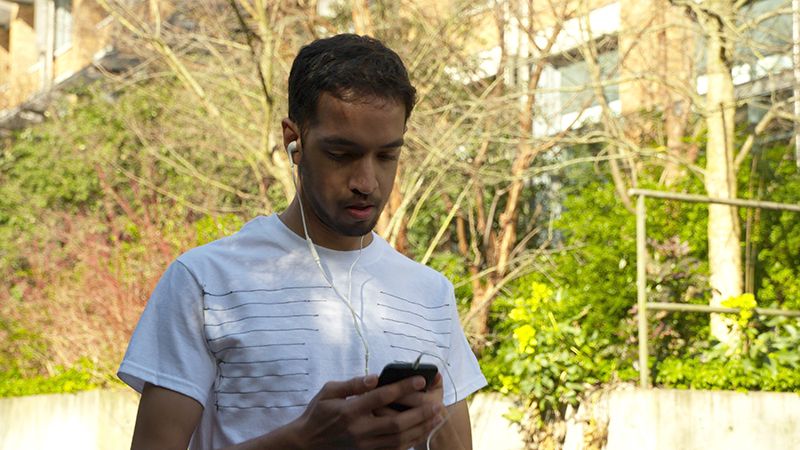In Smart Cities of the Future, Posters and Street Signs Can Talk
University of Washington engineers show how “smart” posters can send a message via FM radio waves to smartphone or car radio
/https://tf-cmsv2-smithsonianmag-media.s3.amazonaws.com/filer/c4/98/c498e93c-472c-419c-a83c-e84527ca63c2/bus-stop-poster.jpg)
One day, signs may be able to talk to us through our phones and our car radios.
Okay, so this may not be a technological breakthrough you’ve long awaited. Given how much time we already spend interacting with devices, you may be wondering if we really need to have more opportunities for inanimate objects to communicate with us.
Allow Vikram Iyer to explain.
“We think this is a technique that can really be used in smart cities to provide people with information when they’re outdoors,” he says.
Iyer is part of an engineering team at the University of Washington that just published a study showing how FM radio waves can be used to transmit data and audio from a sign, or even clothing.
The research shows that it is possible for a smart phone or a car radio to play a message sent from a “smart” poster via FM radio signals, instead of relying on WiFi or Bluetooth to transmit it. This involves a technique known as “backscattering,” where audio and data are transmitted on top of existing FM broadcast signals.
“With Bluetooth and WiFi, all the energy has to come from the battery,” Iyer explains. “But we used the energy already being blasted out by those big FM antenna towers.”
The result is that backscattering requires much, much less energy, meaning an outdoor poster or sign could share a message for years while using next to no power.
A singing poster
To test their technology, the engineering team created a “singing poster” for a musical group named Simply Three, and put it up near a bus stop. To make the poster “sing,” it needed an antenna with some electronics. The scientists came up with a simple solution.
“We put very thin copper tape on the back of the poster,” explains Anran Wang, a doctoral engineering student and one of the study’s co-authors. That essentially enabled the poster to act like a mini-FM radio station.
Then the scientists tuned into a local NPR station upon whose ambient radio signal their data—the group’s music—were piggybacking. The poster was able to manipulate the signal in a way that encoded a sample Simply Three song on top of the NPR news broadcast. Smartphones were able to pick up the music from 10 to 12 feet away, while a car radio 60 feet away could play the music.
The team also did a variation of the experiment using a T-shirt. Using FM radio waves, the shirt, with conductive thread woven into it, was able to act as an antenna and transmit data to a smartphone. That showed that clothing could be used with sensors to monitor a person’s vital signs without the need for constant recharging.

Smarter cities
The scientists were primarily focused on proof of concept, and they appear to be the first research team to prove this method of tapping into existing radio signals can work.
Iyer thinks the technology could be ready for broader application within a year or so. How it might ultimately be used is open to speculation, but he believes there are plenty of possibilities beyond promoting music groups.
“We’ve got signs everywhere on city streets,” he says. “With this kind of technique, you could have them providing helpful information to people. One example might be to communicate with blind people about what’s around them. Or it might be used to tell people about nearby attractions.”
Others on the team have suggested that talking signs could provide more details about upcoming events or provide a link to where a person can buy discounted tickets.
Not that these signs would talk to just anyone passing by. You would need to have your smartphone or radio tuned to a designated FM station. Maybe one day, says Iyer, a specific radio band could be set aside for these kinds of transmissions.
That’s one of the many details about the technique that could be addressed as cities and companies start to take a closer look at how they might use it.
For their part, the researchers have shown it can work, and provide another option—a particularly low-cost one—for an increasingly connected world.
“All technology and advertising is moving in that direction,” says Iyer. “Part of the reason we targeted low-power applications for outdoor environments is that they need to be able to broadcast continuously. You can’t do that with Bluetooth or WiFi.
“We’ve enabled a capability that wasn’t here before.”
/https://tf-cmsv2-smithsonianmag-media.s3.amazonaws.com/accounts/headshot/randy-rieland-240.png)


/https://tf-cmsv2-smithsonianmag-media.s3.amazonaws.com/accounts/headshot/randy-rieland-240.png)